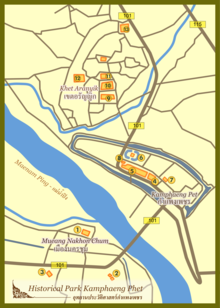Kamphaeng Phet Historical Park
| Historic Town of Sukhothai and Associated Historic Towns | |
|---|---|
| Name as inscribed on the World Heritage List | |
 |
|
| Location | Thailand |
| Type | Cultural |
| Criteria | i, iii |
| Reference | 574 |
| UNESCO region | Asia-Pacific |
| Inscription history | |
| Inscription | 1991 (15th Session) |
Kamphaeng Phet Historical Park is an archeological site in Kamphaeng Phet, Thailand. Along with Sukhothai Historical Park and Si Satchanalai historical park, it is a part of the UNESCO World Heritage Site Historic Town of Sukhothai and Associated Historic Towns. Major features in the Kamphaeng Phet Historical Park include archaeological remains of ancient sites such as Mueang Chakangrao to the east of the Ping River, Mueang Nakhon Chum to the west and Mueang Trai Trueng some 18 km from the town to the southwest. Chakangrao, the ancient Kamphaeng Phet town, had the same town planning concept as the old Sukhothai and Si Satchanalai, with separate zones for religious sites both within and outside of town limits. Structures are usually large and made of laterite. Religious sites on the west bank of the Ping River at Nakhon Chum are built of bricks and of smaller size.
City walls and old fortifications mark the boundary of the rectangular town area, measuring 300–700 metres wide and 2,200 metres long.
Wat Phra Kaeo (วัดพระแก้ว) is a large royal temple in town centre near a site believed to have been a palace. The temple itself was used on important city events and had no monks in residence. Major features include the principal chedi with lion-adorned base and a round chedi with elephant-adorned base. There are also other Chedis of different bases and remains of several chapels. Its boundary is marked off by laterite walls.
Second in size to Wat Phra Kaeo is Wat Phra That (วัดพระธาตุ). Here the principal Chedi is built of mixture of laterite and bricks with a 15-metre wide square base. The style is of Kamphaeng Phet architecture.
Sa Mon (สระมน) is the site of the palace to the north of Wat Phra Kaeo with a square earthen wall almost touching the northern city wall. Surrounding the walls on three sides are moats with a pond in the middle. There are no standing structures remaining today.
Wat Phra Non (วัดพระนอน) is enclosed by laterite walls on four sides. At the front of the temple are a square-shaped pond, restrooms, and an ancient floating pavilion which is supported by a large laterite column. The entire column was cut out in one single piece from its source and measures 1.1 m on each side and 6.4 m in height, the largest such stone in the country. A lion sculpture and Sema stones (boundary stones) can still be discerned. The large vihan which once housed the reclining Buddha has crumbled entirely.
...
Wikipedia
